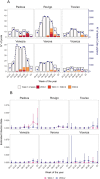Rapid spread of a new West Nile virus lineage 1 associated with increased risk of neuroinvasive disease during a large outbreak in northern Italy, 2022: One Health analysis
- PMID: 36331269
- PMCID: PMC11646088
- DOI: 10.1093/jtm/taac125
Rapid spread of a new West Nile virus lineage 1 associated with increased risk of neuroinvasive disease during a large outbreak in northern Italy, 2022: One Health analysis
Erratum in
-
Correction to: Rapid spread of a new West Nile virus lineage 1 associated with increased risk of neuroinvasive disease during a large outbreak in Italy in 2022.J Travel Med. 2024 Jul 7;31(5):taae047. doi: 10.1093/jtm/taae047. J Travel Med. 2024. PMID: 38531066 Free PMC article. No abstract available.
Abstract
Background: A new strain of WNV lineage 1 (WNV - 1) emerged in the Veneto Region, northern Italy, in 2021, eight years after the last outbreak of WNV - 1 in Italy. The virus, which co-circulates with WNV-2, has become endemic in the Region, where, in 2022, most human cases of neuroinvasive disease (WNND) reported in Europe have occurred.
Methods: Comparative analysis of the epidemiology and clinical presentation of WNV-1 and WNV-2 infection in humans, as well as the temporal and geographic distribution of WNV-1 and WNV-2 among wild birds and Culex pipiens mosquitoes in Veneto, from May 16th to August 21st, 2022, to determine if the high number of WNND cases was associated with WNV-1.
Results: As of August 21st, 2022, 222 human cases of WNV infection were confirmed by molecular testing, including 103 with fever (WNF) and 119 with WNND. WNV lineage was determined in 201 (90.5%) cases, comprising 138 WNV-1 and 63 WNV-2 infections. During the same period, 35 blood donors tested positive, including 30 in whom WNV lineage was determined (13 WNV-1 and 17 WNV-2). Comparative analysis of the distribution of WNV-1 and WNV-2 infections among WNND cases, WNF cases and WNV-positive blood donors showed that patients with WNND were more likely to have WNV-1 infection than blood donors (odds ratio 3.44; 95% CI 95% 1.54 to 8.24; p = 0.0043). As observed in humans, in wild birds WNV-1 had higher infectious rate (IR) and showed a more rapid expansion than WNV-2. At variance, the distribution of the two lineages was more even in mosquitoes, but with a trend of rapid increase of WNV-1 IR over WNV-2.
Conclusions: Comparative analysis of WNV-1 vs WNV-2 infection in humans, wild birds, and mosquitos showed a rapid expansion of WNV-1 and suggested that WNV-1 infected patients might have an increased risk to develop severe disease.
Keywords: West Nile virus; bird; fever; lineage; mosquito; neuroinvasive disease.
© The Author(s) 2022. Published by Oxford University Press on behalf of International Society of Travel Medicine.
Conflict of interest statement
None declared.
Figures




References
LinkOut - more resources
Full Text Sources
Molecular Biology Databases
Research Materials

